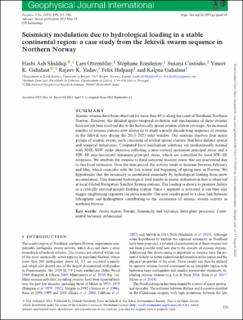| dc.contributor.author | Shiddiqi, Hasbi Ash | |
| dc.contributor.author | Ottemöller, Lars | |
| dc.contributor.author | Rondenay, Stephane | |
| dc.contributor.author | Custódio, Susana | |
| dc.contributor.author | Gahalaut, Vineet K | |
| dc.contributor.author | Yadav, Rajeev K | |
| dc.contributor.author | Halpaap, Felix Julian | |
| dc.contributor.author | Gahalaut, Kalpna | |
| dc.date.accessioned | 2023-08-28T11:36:07Z | |
| dc.date.available | 2023-08-28T11:36:07Z | |
| dc.date.created | 2023-06-30T13:53:41Z | |
| dc.date.issued | 2023 | |
| dc.identifier.issn | 0956-540X | |
| dc.identifier.uri | https://hdl.handle.net/11250/3085996 | |
| dc.description.abstract | Seismic swarms have been observed for more than 40 yr along the coast of Nordland, Northern Norway. However, the detailed spatio-temporal evolution and mechanisms of these swarms have not yet been resolved due to the historically sparse seismic station coverage. An increased number of seismic stations now allows us to study a nearly decade-long sequence of swarms in the Jektvik area during the 2013–2021 time window. Our analysis resolves four major groups of seismic events, each consisting of several spatial clusters, that have distinct spatial and temporal behaviours. Computed focal mechanism solutions are predominantly normal with NNE–SSW strike direction reflecting a near-vertical maximum principal stress and a NW–SE near-horizontal minimum principal stress, which are controlled by local NW–SE extension. We attribute the swarms to fluid-saturated fracture zones that are reactivated due to this local extension. Over the time period, the activity tends to increase between February and May, which coincides with the late winter and beginning of spring time in Norway. We hypothesize that the seismicity is modulated seasonally by hydrological loading from snow accumulation. This transient hydrological load results in elastic deformation that is observed at local Global Navigation Satellite System stations. The loading is shown to promote failure in a critically stressed normal faulting system. Once a segment is activated, it can then also trigger neighboring segments via stress transfer. Our new results point to a close link between lithosphere and hydrosphere contributing to the occurrence of seismic swarm activity in northern Norway. | en_US |
| dc.language.iso | eng | en_US |
| dc.publisher | Oxford University Press | en_US |
| dc.rights | Navngivelse 4.0 Internasjonal | * |
| dc.rights.uri | http://creativecommons.org/licenses/by/4.0/deed.no | * |
| dc.title | Seismicity modulation due to hydrological loading in a stable continental region: A case study from the Jektvik swarm sequence in Northern Norway | en_US |
| dc.type | Journal article | en_US |
| dc.type | Peer reviewed | en_US |
| dc.description.version | publishedVersion | en_US |
| dc.rights.holder | Copyright 2023 The Author(s) | en_US |
| cristin.ispublished | true | |
| cristin.fulltext | original | |
| cristin.qualitycode | 2 | |
| dc.identifier.doi | 10.1093/gji/ggad210 | |
| dc.identifier.cristin | 2159927 | |
| dc.source.journal | Geophysical Journal International | en_US |
| dc.source.pagenumber | 231-246 | en_US |
| dc.identifier.citation | Geophysical Journal International. 2023, 235 (1), 231-246. | en_US |
| dc.source.volume | 235 | en_US |
| dc.source.issue | 1 | en_US |

